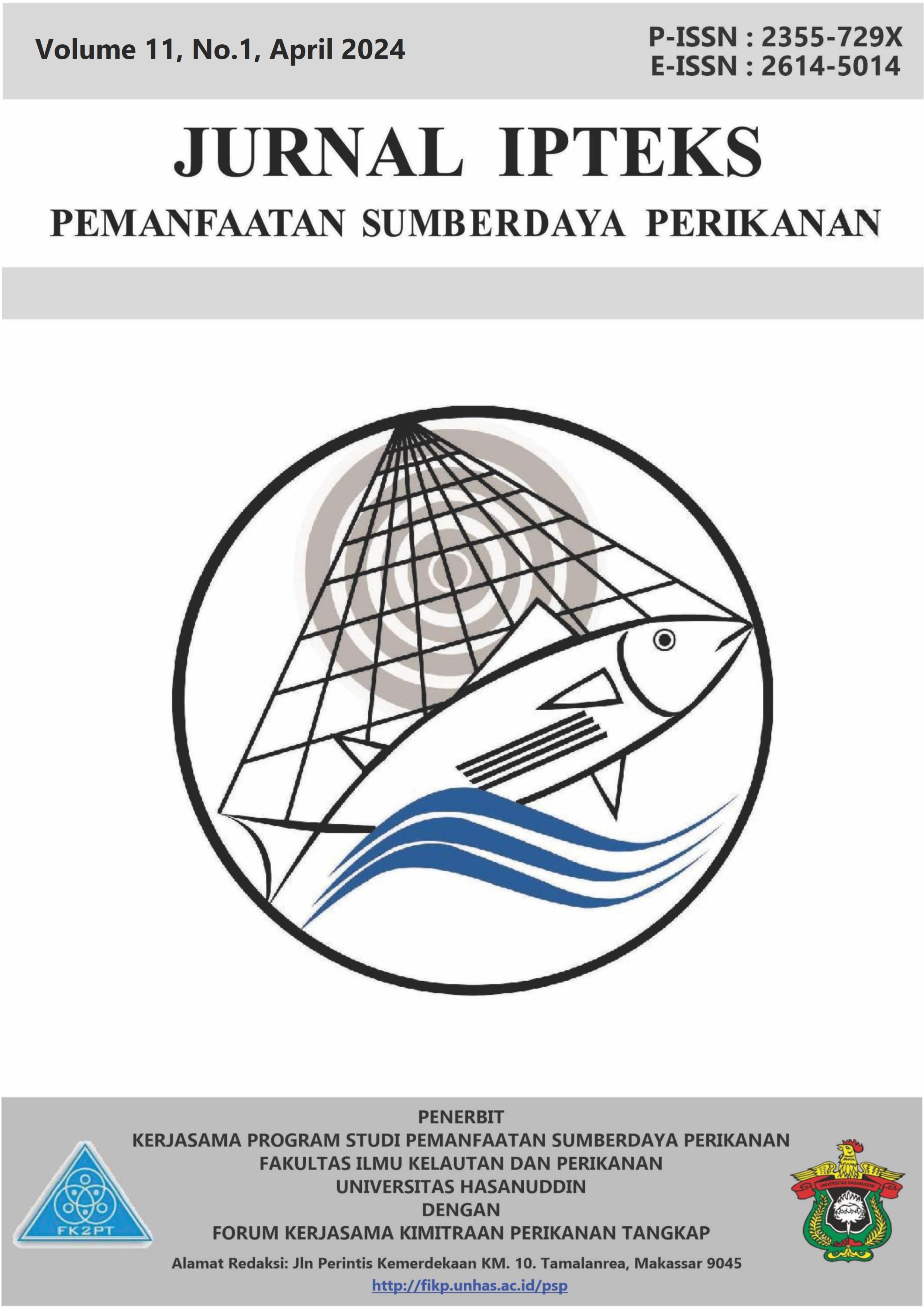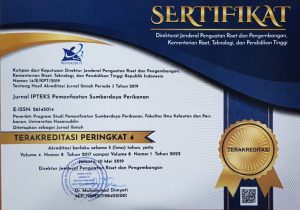Macrozoobentos Community Structure at Ecoshrimp Reservoir Pond, Waetuoe Village, Lanrisang District, Pinrang Regency
DOI:
https://doi.org/10.20956/jipsp.v11i1.20772Keywords:
Abundance, Ecoshrimp, Macrozoobenthos, Reservoir, Sermyla requtiiAbstract
Mollusc has great commercial benefits in capture fisheries and aquaculture. However, it can also cause economic losses and human suffering. Some macrozoobenthos of the mollusc species are intermediate hosts for parasites and pests in aquaculture pond systems. The reservoir in the pond is a sedimentation area and a biofilter to optimize water quality before flowing into the pond. This study aims to analyze macrozoobenthos community structure at the ecoshrimp reservoir pond located in Waetuoe Village, Lanrisang District, Pinrang. Macrozoobenthos sampling was carried out using a 1x1 m quadrant-transect. The results showed that the identified molluscs consisted of eight species grouped into four families and two classes, including Gastropods and Bivalves. The abundance of macrozoobenthos at the pond's edge was smaller than those in the middle part (994 individuals vs. 1095 individuals). Sermyla requtii was the species with the highest density of 350 ind/m2 at the edge and 670 ind/m2 in the middle of the reservoir. The frequency of occurrence of macrozoobenthos at both observation sites has a value of > 25%. The diversity index at the edge of the reservoir (1.7015) and in the middle of the reservoir (1.2533) is relatively moderate. The uniformity index value at the edge of the reservoir (1.8620) and in the middle of the reservoir (1.3715) is relatively high. The dominance index value at the edge of the reservoir (0.2192) and in the middle of the reservoir (0.4124) is relatively low. The particle size analysis shows that the sediment type in the reservoir is medium sand with an average median value (d50) of 0.29 mm.
References
Agustinii, M., Muhajir, & Icak, (2019). Keanekaragaman Makrozoobentos pada Budidaya Polikultur di Desa Sawohan Kecamatan Sedati Kabupaten Sidoarjo. Jurnal Hasil Penelitian (JHP17). 04(2):148–158. [Indonesia]
Alwi, D., Muhammad, S.H., & Herat, H. (2020). Keanekaragaman dan Kelimpahan Makrozoobenthos pada Ekosistem Mangrove Desa Daruba Pantai Kabupaten Pulau Morotai. Jurnal Enggano. 5(1):64–77. [Indonesia]
Antoni, Febri, S. P. (2017). Moluska Bakau sebagai Alternatif Sumber Pangan Berdaulat. Jurnal Ilmiah Samudra Akuatika. 1(1):6–11. [Indonesia]
Atjo, A. S. (2016). Kabupaten Pinrang Kembangkan Udang Windu Organik - Tribunnews. tribunners.
Barrientos-Luján, N. A., Zaragoza, F. A. R., & Perez, A. L. (2021). Richness, abundance and spatial heterogeneity of gastropods and bivalves in coral ecosystems across the Mexican Tropical Pacific. Journal-of-Molluscan-Studies-1464-3766. 87(2).
Brower, J. E., & Zar, J. H. (1998). Field and Laboratory Methods for General Ecology. Company Pubi. Dubuque Lowa.
Carpenter, K., & Niem, V. H. (1998). The Living Marine Resources of the Western Central Pacific Volume 2: Cephalopods, Crustaceans, Holothurians and Sharks. FAO. Rome.
Choirudin, I. R., Supardjo, M. N., & Muskananfola, M. R. (2014). Studi Hubungan Kandungan Bahan Organik Sedimen dengan Kelimpahan Makrozoobenthos di Muara Sungai Wedung Kabupaten Demak. Diponegoro Journal of Maquares Management of Aquatic Resources. 3(3):168–176. [Indonesia]
Dharma, B. (1988). Siput dan Kerang Indonesia (Indonesian Shells I). PT Sarana Graha. Jakarta. [Indonesia]
Dharma, B. (1992). Siput dan Kerang Indonesia (Indonesian Shells II). PT Sarana Graha. Jakarta., [Indonesia]
Hasibuan, J., Nasution, S., & Tanjung, A. (2018). Struktur Populasi dan Kematangan Gonad Gastropoda Telescopium telescopium pada Perairan Pantai Ketapang Desa Sungai Cingam Kecamatan Rupat Kabupaten Bengkalis. 2:6. [Indonesia]
Imai, T. (1971). Aquaculture in shallow seas. Progress in Shallow Seas Culture. Oxford & IBH Publishing Co., New Delhi, Bombay, Calcuta. 615 p.
Insafitri, (2010). Keanekaragaman, Keseragaman, dan Dominansi Bivalvia di Area Buangan Lumpur Lapindo Muara Sungai Porong. Jurnal Kelautan. Universitas Trunojoyo. 3(1):54–59. [Indonesia]
Irmawati, Malina, A. C., Alimuddin, & Kadriah, I. A. K. (2021a). Budidaya Ikan Kakap Putih: Tinjauan Kelayakan di Keramba Jaring Apung dan Tambak Tradisional. CV. Nas Media Pustaka. [Indonesia]
Irmawati, Malina, A. C., Husain, A. A. A., Annisa, A. R., Kadriah, I. A. K., & Alimuddin, A. (2021b). Genetic variation in the Asian seabass (Lates calcarifer Bloch, 1790) from Wallacea Region estimated using random amplified polymorphic DNA (RAPD) markers Genetic variation in the Asian seabass (Lates calcarifer Bloch, 1790) from Wallacea Region. IOP Conference Series: Earth and Environmental Science.
Karepesina, S. B. G. (2018). Perubahan Struktur Komunitas Makrozoobentos pada Perairan Estuari Bili-Bili berdasarkan Gradien Salinitas di Kelurahan Tellumpanua, Kecamatan Suppa, Kabupaten Pinrang. [Skripsi]. Universitas Hasanuddin. [Indonesia]
Kariono, M., Ramadhan, A., & Bustamin, (2013). Kepadatan dan Frekuensi Kehadiran Gastropoda Air Tawar di Kecamatan Gumbasa Kabupaten Sigi. Jurnal Ilmu Biologi. 1:57–64. [Indonesia]
Khalil, M., Ezraneti, R., Jannatiah, & Hajar, S. (2016). Penggunaan Keong Bakau Telescopium sp (Gastropoda: Potamididae) dan Siput Bakau Cerithidea sp (Gastropoda: Potamididae) Sebagai Biofilter terhadap Limbah Budidaya Ikan Bandeng (Chanos chanos). Omni-Akuatika. 12(3):88–97. [Indonesia]
Krebs, C. J. (1985). Ecology The Experimental Analysis of Distribution and Abundance. Haper Inte ed. Harper & Row, Publishers., New York.
Kurniawati, A., Bengen, D. G., & Maduppa, H. (2014). Karakteristik Telescopium telescopium pada ekosistem mangrove di Segara Anakan , Kabupaten Cilacap , Jawa Tengah. Bonorowo Wetlands. 4(2):71–81. [Indonesia]
Lentge-maaß, N., Neiber, M. T., Gimnich, F., & Glaubrecht, M. (2021). Evolutionary systematics of the viviparous gastropod Sermyla (Gastropoda : Cerithioidea : Thiaridae ), with the description of a new species. Zoological journal of the linnean society. 192:736–762.
Linberg, D. (2001). Molluscs in Ensiclopedia of Biodiversity (2nd edution), Editor-in-Chief: Levin RA, 2013. Elseveir, 373-383 p.
Munandar, A., Ali, M. S., & Karina, S. (2016). Struktur Komunitas Makrozoobenthos di Estuari Kuala Rigaih Kecamatan Setia Bakti Kabupaten Aceh Jaya. Jurnal Ilmiah Mahasiswa Kelautan dan Perikanan Unsyiah. 1(3):331–336. [Indonesia]
Nützel, A. (2021). Gastropods as Parasites and Carnivorous Grazers: A Major Guild in Marine Ecosystems. In: De Baets K., Huntley J.W. (eds) The Evolution and Fossil Record of Parasitism. Topics in Geobiology, vol 49. Springer, Cham.
Odum, E. P. (1996). Dasar-dasar Ekologi. Edisi Keti ed. Gajah Mada Universitas Press., Yogyakarta. [Indonesia]
Pina, S., Russell-Pinto, F., & Rodrigues, P. (2011). Description of Maritrema Portucalensis sp. nov. (Digenea, Microphallidae) parasite of Carcinus maenas (Crustacea, Decapoda) from Aveiro estuary, Northern Portugal. Acta Parasitol 2011; 56(4): 377-84.
Pong-Masak, P. R., & Pirzan, A. M. (2006). Macrozoobenthos Community at the Pond Culture Area in Malakosa Coastal, Parigi-Moutong, Central of Sulawesi. Biodiversitas Journal of Biological Diversity. 7(4):354–360.
Russel-Pinto, F., Gonçalves, J., & Bowers, E. (2006). Digenean larvae parasitizing Cerastoderma edule (Bivalvia) and Nassarius reticulatus (Gastropoda) from Ria de Aveiro, Portugal. J Parasitol; 92(2): 319-32.
Setiyo, M. (2019). Kelompok Hama Dalam Budidaya Ikan dan Cara Menanggulanginya. Biota Dunia Perairan. [Indonesia]
Sijaya, M. T. D. (2016). Penilaian Produktivitas Perairan dengan Menggunakan Makrozoobentos sebagai Indikator di Perairan Kabupaten Mamuju. [Skripsi] Universitas Hasanuddin. [Indonesia]
Wishnu, N. P., Hartati, R., Suprijanto, J., Soenardjo, N., & Santosa, G. W. (2020). Komunitas Makrozoobentos pada Substrat Dasar Lunak Di Muara Sungai Wulan, Demak. Buletin Oseanografi Marina. 9(1):19–26. [Indonesia]
WoRMS, E. (2021). World Register of Marine Species. http://www.marinespecies.org at VLIZ, accessed 2021, doi: 10.14284/170.
Yulianto, A. (2006). Keanekaragaman Kepiting di Hutan Mangrove Desa Tungkal, Tanjung Jabung Barat, Jambi. [Skripsi] Fakultas Perikanan. Bogor. [Indonesia]
Zala, M., Sipai, S., Bharpoda, T., & Patel, B. (2018). Molluscan pests and their management : a review. Agres. 7(2):126–132. [Indonesia]
Downloads
Published
How to Cite
Issue
Section
License
Copyright (c) 2024 Jurnal IPTEKS Pemanfaatan Sumberdaya Perikanan

This work is licensed under a Creative Commons Attribution 4.0 International License.














